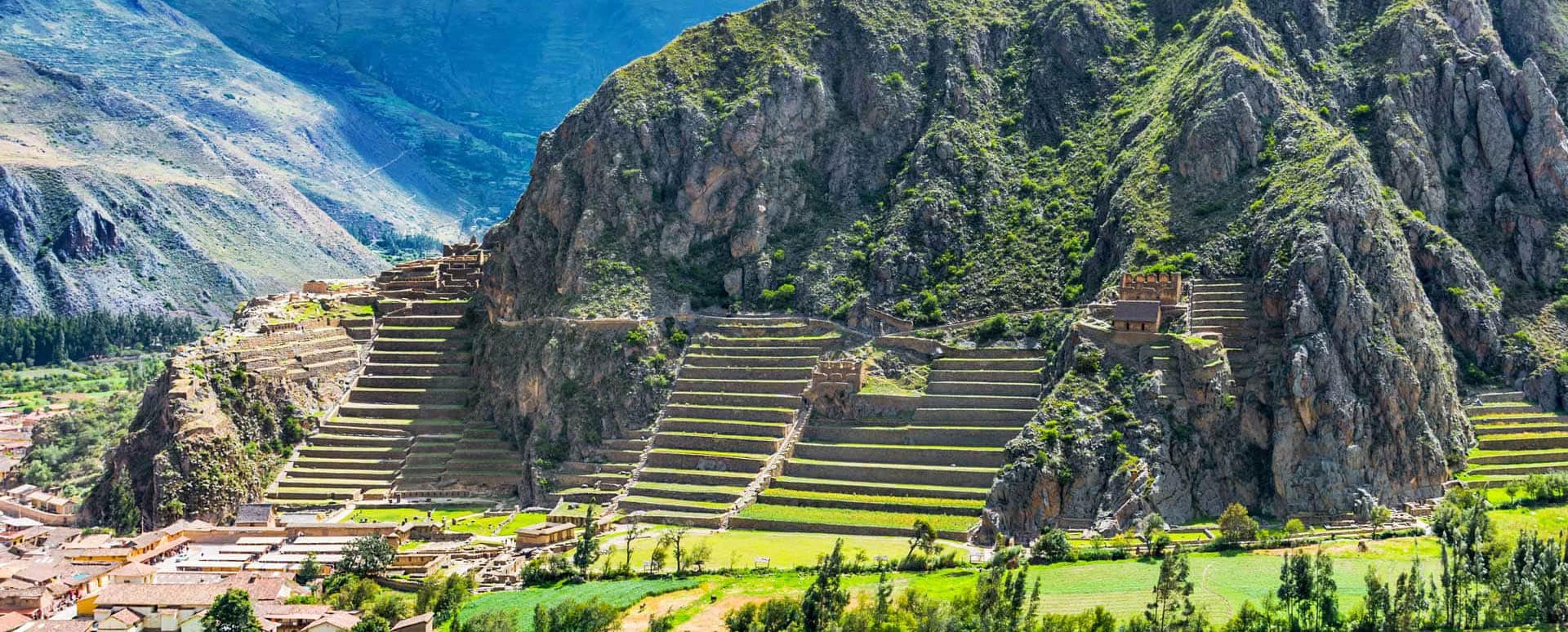OVERVIEW
There are several companies that offer tours through the Sacred Valley. Not every company will design tours the same, so shop around to find the one that best suits your interest. The best companies will take you to the highlights of the Sacred Valley, such as the archeological sites of Pisac, Ollantaytambo, Moray, and the Maras Salt Mines, rather than just focusing on various markets for shopping. Look for all of this to be provided in a small group of no more than 8 persons or a private tour with a guide who is passionate about Inca history.
The area of the valley between Pisac and Ollantaytambo is known as the Sacred Valley of the Incas. On this tour, you will drive through the mountains of the Sacred Valley, which played a key role in Inca culture and history. The Valley has a milder climate and is at a lower altitude than Cusco. You will see a succession of picturesque villages, ancient Inca terraces, and some of the most important archeological sites.
Sacred Valley Map Full Day
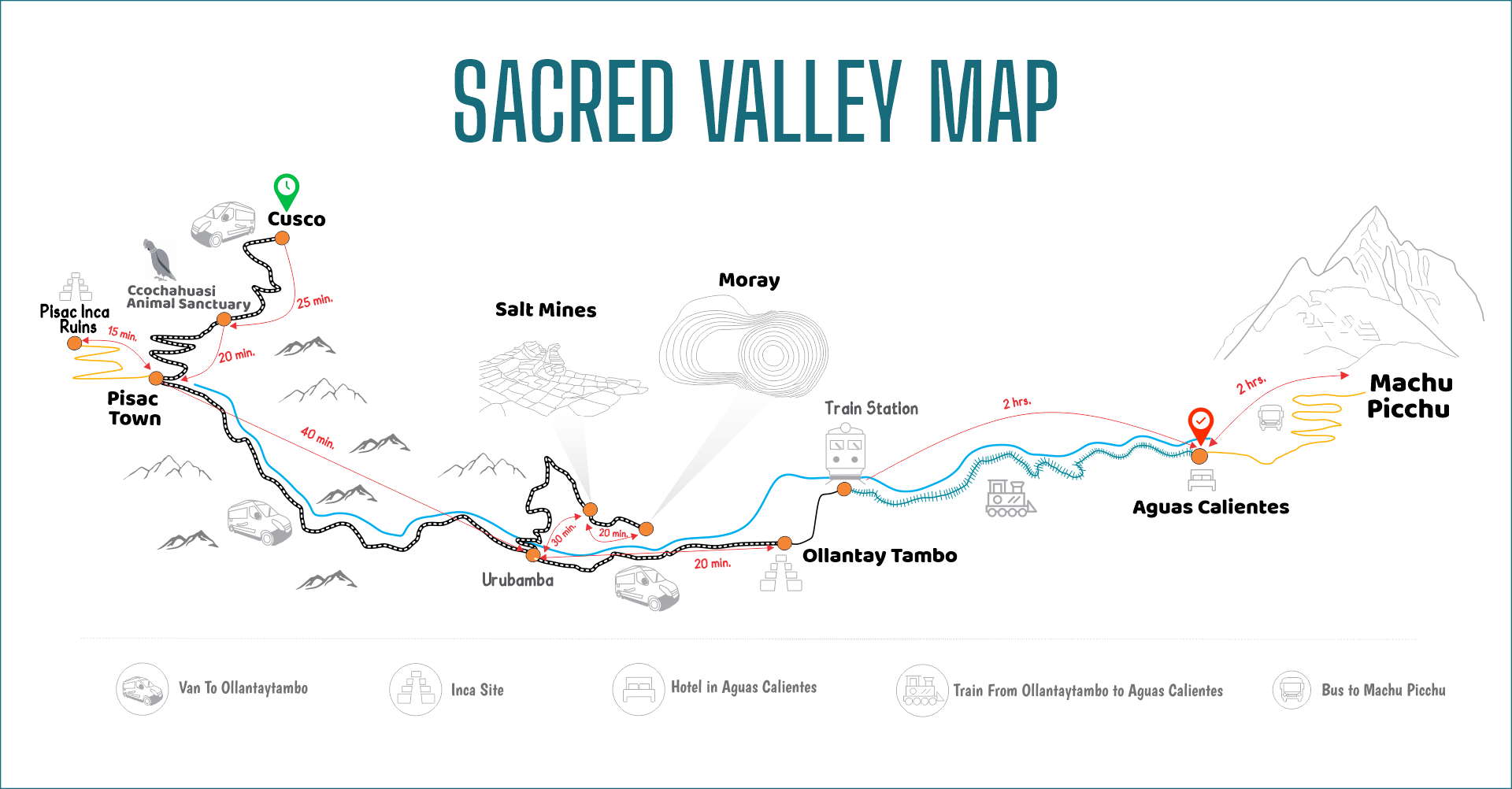
SACRED VALLEY ITINERARY & PRICES
The most comprehensive tour of Sacred Valley is offered by SAM Travel Peru and Orange Nation Peru. No other travel agencys except SAM Travel and Orange Nation visits all of these sites below in their Sacred Valley Tour! Check out the brief important points of interest below.
- Manos de la Comunidad. A camelid farm home to all 4 South American species, the llama, alpaca, guanacos and vicuña
- The spectacular viewpoint of the Sacred Valley (Mirador of Taray)
- The extensive Pisac Inca ruins, which have many impressive examples of Inca architecture
- A quick stop at Urubamba for lunch (not included in price)
- The Moray Archeological site where you can learn about Incan agricultural experimentation
- The famous Pre-Inca Salt Mines of Maras where naturally salty spring water is gathered in the same way it has been for hundreds of years
- The magnificent archeological site of Ollantaytambo and amazing views of the valley
Sacred Valley of the Incas Tour Itinerary:
Your guide will pick you up from your hotel lobby at 7am. First, we drive to a close-by Camelid (llama and Alpaca) farm. Here you have an opportunity to feed and pet different breeds of alpacas, llamas and vicuñas (a rare and national animal of Peru). Watch local women using wool from the animals around to weave beautiful garments with different patterns. They have their natural dyeing process with all the organic material needed on full display. Visit their museum and souvenir shop with the option of purchasing a good selection of fair-trade alpaca and vicuña apparel. Best part is that inside the shop there are (english speaking) shopping assistants to answer all your question but they do not pressure you into purchasing anything. Be sure to grab your certification if you purchase merchandise made with Vicuñas wool, they are protected by the government of Peru.
Next stop is the Mirador of Toray. Enjoy unspoiled views of the valley below, with its lush vegetation and the serene Urubamba River gently curving its way through the entire the Sacred Valley. Perfect spot to stop for selfies, this area has the most panoramic views of the valley and the lighting is perfect at this time of the morning.
PISAC
After a short uphill drive, we make our way to the historical Archeological site of Pisac. Learn about the agricultural practices of the Incas. How they used the different level of the terraces below with varying micro-climates for their farming and then built their living quarters and food storage warehouses at the top of the hills, to take advantage of the cooler temperatures in order to preserve their produce. Discover at this Sacred Valley entry point the value this region had in terms of sustenance to the Incas and modern Cusco alike. The biggest Inca cemetery is also located here, with thousands of niches wrapped around the mountain side adjacent to the archeological site. According to local legend, there are still human remains inside some of the gravesites.
After our knowledgeable tour, we beging a scenic drive through the valley, passing a small rural town with locals going about their normal day to day lives. We stop on the outskirts of Sacred Valleys´ commercial town of Urubamba for our lunch. Enjoy a scrumptious buffet lunch, with an impressive spread. The food is in abundance, with a great selection for different dietary needs. (Lunch is not included)
SALT MINES
After filling up our bellies, we head over to the Pre-Inca Salt Mines of Salineras. As you approach the salt mines you will be met by thousands of salt pans that has the valley coated in white and a murky brown color. The locals have been mining salt for generations. They have full ownership and rights to these pans and have passed them from one generation to the next. The small stream at the top fills up all the salt pans and once the water evaporates, they cultivate the salt to be sold for profit. Over 90% of the salt consumed in Peru comes from this humble small town. Any salt bought from the vendors at the mines, directly supports this small local community.
MORAY
Next, we visit another set of Inca Ruins. The ruins of Moray are a great example of how advanced the Incas were for that period. Even though they did not build the initial structure, they did however see the opportunity to use this as a natural greenhouse. Each terrace layer has a different temperature, they used these different micro-climates to test the optimum growing point of their crops. They even brought in different samples of soil from the Empire to achieve maximum results. The sun also hit each level at different angles, making sun absorption different at every section, they also built an intricate irrigation system that would still flow to this day if it was’nt blocked for preservation. The locals were still using this for farming until it was reserved for tourism in the 70s.
OLLANTAYTAMBO
Finally, we head to the bustling town of Ollantaytambo, the gateway to Machu Picchu and the world-famous Inca trail. Watching over the town is the Archeological site of the same name. This is where the last and greatest battle was fought between the Incas and the Spanish Invaders. Even though, the Incas won this battle, they later retreated further into the jungle because their numbers had been continuously depleting from the Spanish flu and the many wars they had endured. The site has many boulders that had been carved, which had either been damaged from the war or a sign that this site was still incomplete at the time of the invasion. Your guide will give a comprehensive tour of this site and share all the important history associated with it
If you are looking to tour Sacred Valley on your own and only need taxi transport, then you can find the information here!
Spend more time at the Inca cities in small or private groups!
| PRICES | ||
|---|---|---|
| PRICE PER PERSON | PRIVATE SERVICES | |
| From $35 | 1 to 3 persons | $197 |
| 4 to 8 persons | $240 | |
Group Service
* Small groups up to 10 people, subject to availability and all the booking needs to be done at least 48 hours in advance.
* The Price includes ONLY the guide and transportation, meals and entrances are not included.
Private Service
***Private service price is based on the number of people. (see above to see the prices) In the group there will be only your party and the itinerary can be flexible. The tour will be completely private with your own guide, chauffeur and private van No others will be added to the group
* The Price includes ONLY the guide and transportation, meals and entrances are not included.
SACRED VALLEY INFORMATION
Structures like the ones you can see in the towns of Pisac or Ollantaytambo, have made it one of the favorite places for travelers from all over the world, even more because it is the valley you must go through before you can enter the Inca city of Machu Picchu. This Valley was the center of Tahuantinsuyo, the largest known empire in the Western Hemisphere, spanning from Colombia and Ecuador, passing through Peru and Bolivia, to the northern part of the nations of Argentina and Chile; and its capital is the city of Cusco, which was known as the “navel of the world.”
The Sacred Valley for the Incas
With the river feeding the valley, its fertile lands were one of the main centers of food production during the time of the Incas. Some places, such as Moray, were used as agricultural laboratories, to experiment with species of plants brought from across the empire. The Incas cultivated potatoes, white corn, coca, fruits and vegetables, on terraces like those that can be seen in many valley villages specially designed for this purpose. Today the valley produces lucuma, peach, avocado, and one of the best corn varieties in the world.
However, it was more than just an important agricultural center; The Urubamba River Valley, “Willcamayu” for the Incas, was one of the most important elements in the religious cosmology of the Incas. They believed that the flow of the Urubamba was closely linked to constellations and mountains, they also believed that it was the counterpart of the Milky Way on earth.
Where is the Sacred Valley of the Incas?
The Urubamba river valley or “Sacred Valley of the Incas”, is located 15 km northeast of the city of Cusco, and can be reached by a paved road. A trip by car to one of the nearest villages will take around 40 minutes. From there you can move to the other villages in the valley by local transport.
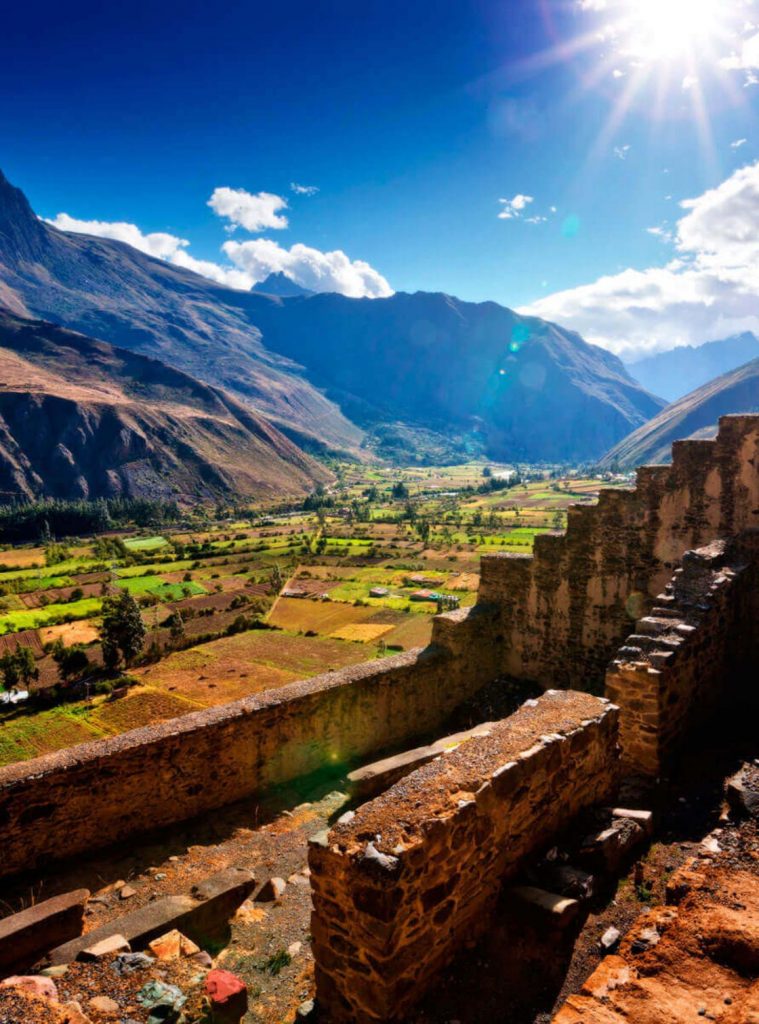
What is the weather like in the valley?
The Sacred Valley of the Incas is 2,800 m.s.n.m., 600 meters below Cusco, and enjoys one of the best climates in this region. Daytime temperatures can vary between 19°C/66°F and 24°C/75°F. This climate made the Incas use it as their main center of agricultural production, experimentation and research. Nowadays, travelers use the valley to acclimatize themselves, before starting their tours through Cusco and Machu Picchu. Without a doubt, it is one of the best ways to avoid altitude sickness.
What to see in the Sacred Valley of the Incas?
Known by the Incas as Willcamayu, the beautiful valley extends from the town of Pisac to Ollantaytambo, along the Urubamba river. The ancient Inca settlements in these cities are presented as checkpoints, before entering the “Inca Trail” that leads to the sacred city of the Incas, Machu Picchu. They are simply amazing, each one more impressive than the one before.
NOTE: Normally to enter to these tourist sites and attractions you need the boleto turistico. This “tourist ticket” allows you to explore all sites in one day!
Pisac
The town of Pisac is located 33 kilometers from the city of Cusco and is presented as the door to the Sacred Valley. It is world famous for its craft market and its impressive archaeological remains, located on a mountain above the town. This town was a kind of capital of the region in the time of the Incas, very important for its excellent location and its fertile lands. The Inca and colonial constructions that are exhibited in this territory are admired for their advanced architecture of polished stones and for the platforms that surround the mountains. More recently, Pisac has become the spiritual center of the Sacred Valley, where you can have all kinds of experiences and spiritual retreats, in addition to meeting people from all over the world who are also interested in this modern interpretation of ancient spirituality.
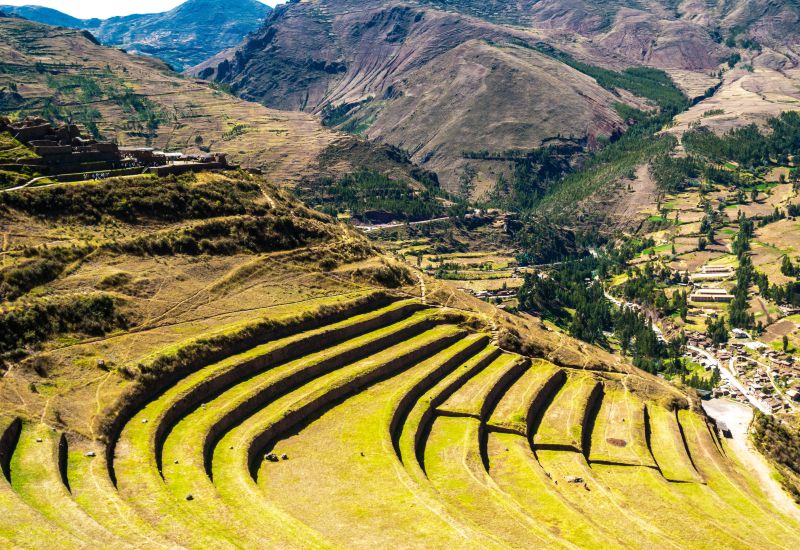
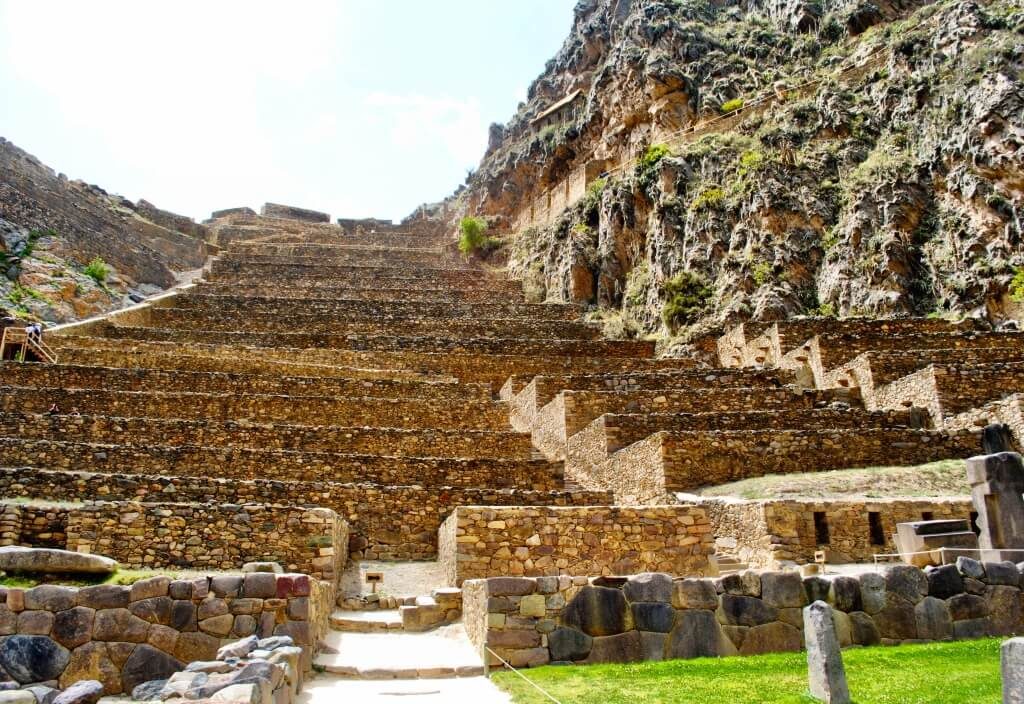
Ollantaytambo
To finish off our incredible day, we drive to Ollantaytambo to explore this quaint Inca village and the amazing Inca Ruins on the hilltop above. These ruins are where the Incas fought their last battle with the Spanish conquerous, before they had to retreat and flee into the dense jungle. Most of the structures were unfortunately incomplete. There is a section with a number of bolders that were carved, but didnt make it to their destination. Another possibility, is that the battle was so intense, it caused a lot of damage to this massive Inca site. Still standing is the incredible architecture of the Sun Temple, admire the water fountains, the Incahuatana and the impressive storehouses. It is believed the site initially belonged to Aymaru clan, before being taken over by the Incas and it stands as the last and best fought battle between the Incas and the Spanish. The Incas won this battle, but due to their depleted numbers from the spanish flu, they had to flee towards the dense jungle. Most tours end here and from the top of the site, you can watch the sunset over the town and the calming river on your right.
Ollantaytambo holds many annual festivals, check online if there is anything coming up during your stay. Its a great tourist hub, with an assortment of restaurants and accomodation establishments for all budgets. Its the gateway to the Inca Trail or the train to Machu Picchu. Once the daily crowds disperse, you are left with a peaceful town, with many indigenous locals, that still call this small town home.
Chinchero
On a normal tour of the Sacred Valley of the Incas, the town of Chinchero will be the one you will visit after touring most of the valley, back to Cusco. It is located 28 km from the city of Cusco at 3,772 m.a.s.l. It has important archaeological sites, a beautiful 17th-century colonial church with canvases of the “Cuzqueña School”, and a typical market where you can practice your bartering skills.
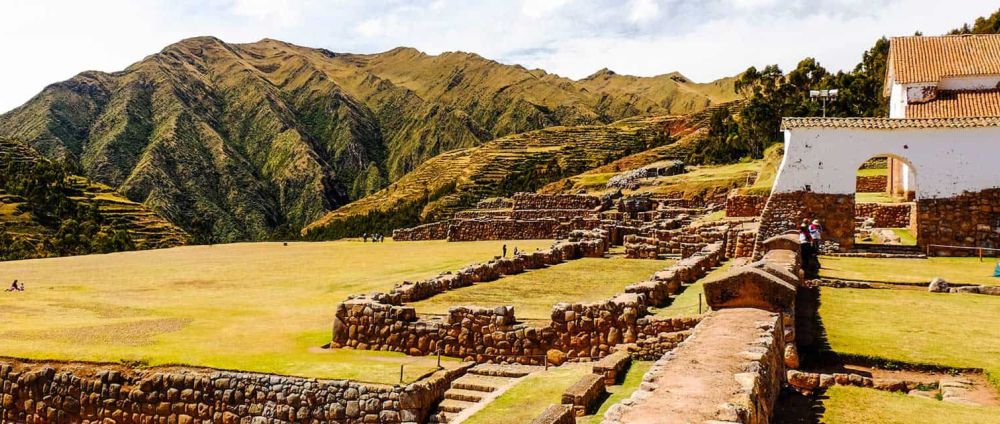
Maras
The Salt Mine (Salineras), close to the colonial town of Maras, are Pre-Inca. Hundreds of saltpans decorate the hillside and have been used for salt extraction since before the Inca era. A natural spring at the top of the valley discharges a small stream of water heavily laden with salt, which is diverted into saltpans and evaporated to produce a salt that is of very high quality. This is one of the few places in the world where you can find naturally pink salt! The locals have full mining rights and all the salt sold on site belongs to the locals. It still supplies Peru with over 90% of its salt. This is a great place to grab another souvenir as all the money will go directly to the people.
The salt mines gives you a taste of an age-old tradition, that has not changed for many generations. The people in this community have been harvesting salt for many years. It’s a rich custom and tradition that has passed saltpans from one generation to the next. This is their main source of income and they have exclusive rights to these mines. Salineras is one of the very few salt mines left in the world to have not switched to more modern techniques. The communal company of Maras (cooperative) packages and distributes the salt and splits the profits with the families according to the number of saltpans they own. A great place to grab another souvenir.
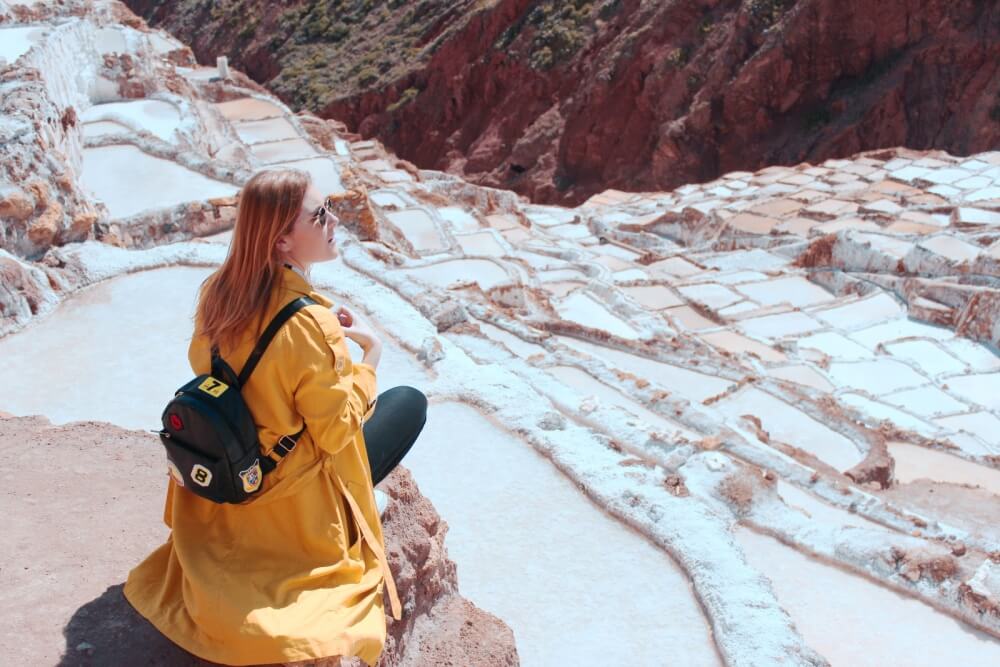
Moray
The town of Moray is 74 km from the city of Cusco, and houses another of the impressive constructions of the Inca. Moray, was an experimental farming site built in the form of an ampitheater with different temperature at each level which grows different types of crops. It is sometimes refered to as the “Greenhouse of the Incas” becuase it functioned the same way a modern greenhouse would function. These levels of terraces were carved before the Incas took control of the Sacred Valley and then used by the Incas to research optimal growing conditions for their crops. The Incas brought in different soil samples from other regions, to optimise their research. The locals were still using it for growing their crops, until the 1970s when it was preserved and protected for tourism
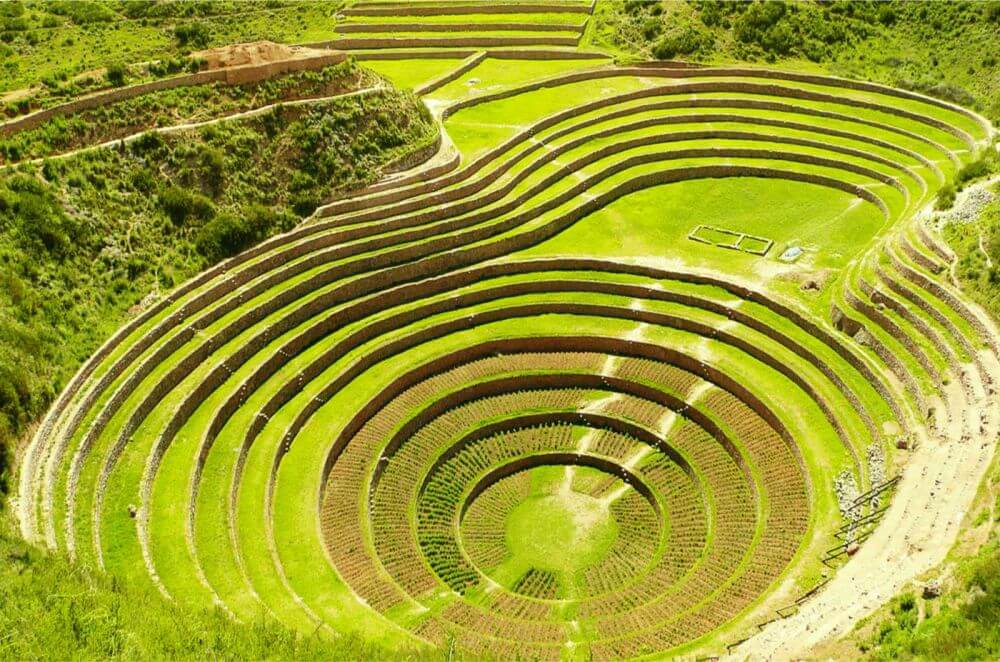
The adventure in the Sacred Valley of the Incas
The Sacred Valley has become incresingly popular in recent years. It is one of the best places to practice outdoor and extreme sports as you can do cycling, hiking, climbing, paragliding, rafting and others. If you are one of the people who enjoy adventure, the outdoors and extreme sports, you cannot miss this opportunity in the Sacred Valley of the Incas.
The cultural tour of the Sacred Valley
The tour of the sacred valley will take you on a markedly traditional route, you will meet Quechua-speaking residents, with typical costumes, working their fields in an artisanal way; It will pass through villages built in the colonial period, through ancient Inca settlements. You will tour markets, temples and city squares that will make you feel as if you traveled back a few hundred years. However, to tour the main archaeological remains of the Sacred Valley, you will need to buy the tourist ticket of Cusco “boleto turistico”.
WHAT IS THE CUSCO BOLETO TURISTICO?
Normally to enter tourist sites and attractions, you would expect to simply turn up and pay your entrance fee on the day, right? Well, that’s no longer the case for some of the biggest archaeological and museum attractions in Cusco and the Sacred Valley of the Incas.
Instead, the boleto turistico is a single ticket which has to be purchased in advance to allow entry to various sites, such as Sacsaywaman, the Pisac and Ollantaytambo ruins. It is not possible to visit or enter these sites without a valid boleto turistico, and it is not possible to buy an individual entry ticket for any single site which is included on the boleto turistico. However, the advantage with purchasing a Boleto Turistico is it gives you the ability to visit ALL the sites!

